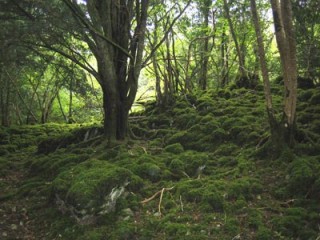The Sacred Tree of Oughterard?
By Paul Gibbons
On the eastern outskirts of Oughterard town lies the townland of Billymore (now often referred to as Billamore). This townland’s name hints at a very ancient past. Billymore has been anglicised from the Irish An Bile Mór. Bile essentially meaning ‘sacred tree’; therefore, An Bile Mór translates to ‘the big sacred tree’.
The ancient Irish didn’t build temples to their Gods like other cultures but instead treated nature as a temple. In fact, certain trees and groves acted like sanctuaries and were often the locations of rituals and celebrations.
Historically, there were five great trees in Ireland: Bile Uisnigh, the ancient tree at Uisneach; Bile Tortan at Ardbreccan in Co. Meath; Craobh Daithi in Co. Westmeath; Eo Rossa, a yew at Old Leighlin in Co. Carlow; and Eo Mugna, an oak at the mouth of the River Shannon. Some of these trees were reputed to be able to shelter a thousand men. However, many other individual trees were considered sacred at a more localised level.
The importance of trees can be seen throughout Irish history and folklore. For instance, each letter of the Ogham alphabet developed in Ireland c. 4th Century referenced a native tree. Even Brehon Law, the native legal system of Ireland which functioned up until the 17th Century provided extensive protection for trees. Trees were classified into five groups:
- Airig Fedo, ‘Nobles of the Wood’ (Chieftain Trees) which included Oak, Hazel, Holly, Yew, Ash, Scots Pine and Wild Apple.
- Aithig Fedo, ‘Commoners of the Wood’ (Peasant Trees) which included Alder, Willow, Hawthorn/Whitethorn, Rowan/Mountain Ash, Birch, Elm, Wild Cherry.
- Fodla Fedo, ‘Lower Divisions of the Wood’ (Scrub Trees) which included Blackthorn, Elder, Spindle Tree, Aspen, Juniper, Whitebeam, Arbitus.
- Iosa Fedo, ‘Bushes of the Wood’ (Bramble Trees) which included Bracken, Bog Myrtle, Gorse/Furze, Bramble/Blackberry, Heather, Broom, Wild Rose/ Dog Rose.
(In some cases the penalty for unlawful felling a ‘Chieftain Tree’ could be the same as the penalty for killing a human chief.)
Trees were the oldest living things and were treated as sources of great wisdom. Fairy Thorns and Rag Trees were considered to be frequently visited by beings of the Otherworld. Mass Bushes served as locations for sermons and Monument Trees as the location for weddings, royal inaugurations, seasonal festivities and other social events. Even today, there still lingers a reverence for fairy trees.
As sacred trees were often planted near or connected with holy wells it is interesting that Billymore is also known as Carrowntobar (Ceathrú an Tobair – ‘Quarter of the well’). The presence of both a sacred tree and a holy well (most likely St. Cummins well now located in Lemonfield) in such close proximity could indicate that the area was of great significance to the ancient inhabitants of the region, serving various religious and ritualistic needs. What rituals took place is unknown; however, the celebration of seasonal festivals such as Bealtaine and Samhain, inagurations of local chieftains and even sacrifices to the Gods could have all taken place under An Bile Mór in Billamore.
(For more information on the importance of trees in Irish history visit livingtreeeducationalfoundation.org/trees_ireland.html)











No Comments
Add a comment about this page